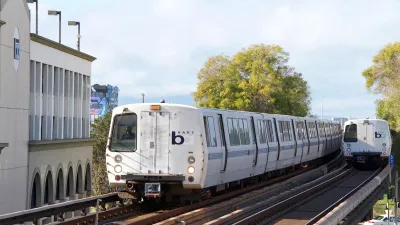Introduced during the pandemic in an area where many residents now work remotely, the new stations have failed to attract new commuters.

Bay Area Rapid Transit (BART), which serves the San Francisco Bay Area, opened two new stations this summer, hoping to draw more commuters to the system with a $2.3 billion extension to Milpitas and Berryessa. To bring BART to the South Bay, VTA, Santa Clara County's transportation authority, agreed to fund the extension and contribute to overall system improvements in exchange for keeping the proceeds from South Bay station fares and parking fees.
With COVID-19 bringing commuting down drastically as many Bay Area workers stay home, ridership to and from the new stations has been disappointing. VTA remains optimistic. "The systems were expanded looking out for 100 years — this is a long, long-term investment," spokesperson Bernize Alaniz told the Mercury News. With thousands of new apartment units going up around the South Bay stations, the agency expects a large influx of new BART riders in the coming months and years. Those who have used the new stations had positive reviews, citing them as "some of the nicest" they'd seen. And while many people can work from home during the pandemic, many essential workers still rely on public transit. Despite low current ridership, now is not the time to make cuts to essential transit services that serve the most vulnerable communities.

Trump Administration Could Effectively End Housing Voucher Program
Federal officials are eyeing major cuts to the Section 8 program that helps millions of low-income households pay rent.

Planetizen Federal Action Tracker
A weekly monitor of how Trump’s orders and actions are impacting planners and planning in America.

Ken Jennings Launches Transit Web Series
The Jeopardy champ wants you to ride public transit.

NYC Open Streets Organizers Call for City Support
The number of open streets projects has dropped year after year as volunteer groups struggle to fund and staff them.

Crime Continues to Drop on Philly, San Francisco Transit Systems
SEPTA and BART both saw significant declines in violent crime in the first quarter of 2025.

How South LA Green Spaces Power Community Health and Hope
Green spaces like South L.A. Wetlands Park are helping South Los Angeles residents promote healthy lifestyles, build community, and advocate for improvements that reflect local needs in historically underserved neighborhoods.
Urban Design for Planners 1: Software Tools
This six-course series explores essential urban design concepts using open source software and equips planners with the tools they need to participate fully in the urban design process.
Planning for Universal Design
Learn the tools for implementing Universal Design in planning regulations.
Heyer Gruel & Associates PA
Ada County Highway District
Institute for Housing and Urban Development Studies (IHS)
City of Grandview
Harvard GSD Executive Education
Toledo-Lucas County Plan Commissions
Salt Lake City
NYU Wagner Graduate School of Public Service





























